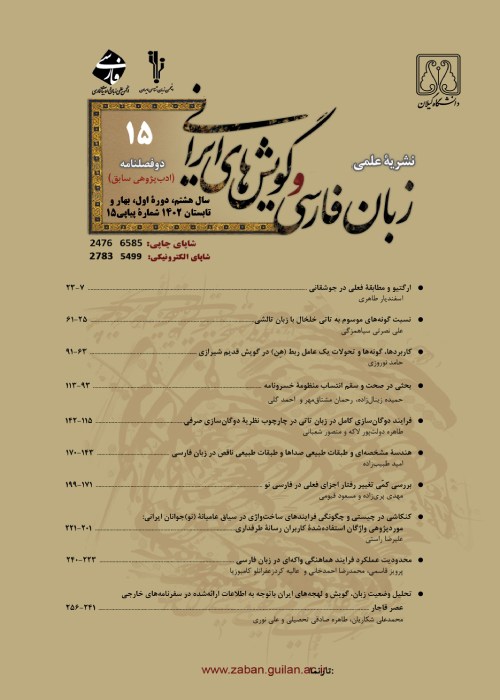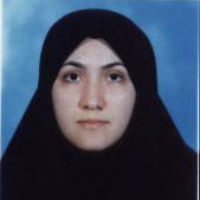Reduplication in Taleshi
Author(s):
Article Type:
Research/Original Article (دارای رتبه معتبر)
Abstract:
Introduction Reduplication is one of the morphological processes that through doubling a word, element, root or stem enhances, emphasizes, amplifies, enlarges, diminishes, adds number or changes verb tense to bring about significant meaning changes or shades of meaning (Kauffman, 2015). Taleshi is a language which is spoken in the northern regions of the Iranian provinces of Guilan and Ardabil and the southern regions of the Republic of Azarbaijan. Based on lexical, phonological and grammatical factors, Taleshi is divided into three dialects: northern, central and southern. Northern Taleshi is spoken in Azarbaijan from Anbaran to Lavandavil; central Taleshi includes Taleshdula, Asalem and Tularud; and southern Taleshi which has been investigated in this article includes Masal, Shanderman, Kushabar and Masule. In this paper, we have studied all types of reduplication proposed by Kauffman (2015) in Taleshi so that we can get the dominant types, uses, and syllable structures of the reduplicated words.
Theoretical framework According to Kauffman (2015), there are eight different kinds of reduplication, including: full reduplication which refers to doubling of the entire word; partial reduplication which uses a part of a word, typically a syllable, and repeats it; reduplication in baby-talk, as babies shorten the words into doubled syllables; rhyming reduplication which refers to different words with near duplicated sounds resulting in rhyming; ablaut reduplication by changing vowels of words that nearly rhyme; reduplication in onomatopoeia by imitating and doubling the sounds in nature; name doubling which is primarily used for close relationships; and shm-reduplication which refers to depreciative reduplication indicating irony, sarcasm, skepticism rhyming base words with the prefix shm-. Applying repetitive sounds result in grammatical or lexical distinctions which make profound or subtle changes in meaning. Therefore, Kauffman (2015) distinguished various uses of reduplication based on forming plurals, verb tenses, intensity, amplification, enhancement, specificity, diversity or collectivity, similarity, playfulness, aimlessness, reciprocity and statements on life.
Methodology The method of this research is both qualitative and quantitative. In order to achieve comprehensive results, the researcher needed to choose perfect and acceptable corpus in Taleshi, so data were collected in two ways: documents and field study. The documents included Taleshis proverbs and also Taleshi to Farsi dictionaries. The field study included interviews and was based on the speech of the old and illiterate speakers of Masal, Shanderman, Shaft and Fuman and also the researchers intuition. After data collection, the entire corpus was searched for the possible eight kinds of reduplication mentioned by Kauffman (2015). Then, all these forms were recorded along with their meanings and parts of speech, then the uses of each kind of reduplication were examined. Together, 281 reduplicated forms were extracted and categorized according to their types, uses and semantic properties. In the end, the syllable structures of each kind of reduplication were presented.
Results & Discussion The researcher collected 281 reduplicated words in Taleshi, including 168 words with full reduplication, 50 words with partial reduplication, 24 words with rhyming reduplication and 39 words with other kinds of reduplication. The parts of speech observed in reduplicated words were nouns, adjectives and adverbs among which noun was the dominant form in most structures. The results of this study showed that all kinds of reduplication except "name doubling" and "Shm-reduplication" were observed in Taleshis data. The semantic uses of reduplication in Taleshi showed that in terms of meaning, the dominant forms were intensity, amplification, enhancement, diversity and collectivity. By analyzing the syllable structures, it was found that in mono- syllables, the structure of CVC and in two syllables, the use of CV-CV and also CV-CVC had the dominant structures in Taleshi reduplicated words. The comparison between this study and the previous ones showed that in the previous studies only one or two types of reduplication like full reduplication and partial reduplication were taken into account, while other types of reduplication were ignored. Also, in the previous researches, the use of reduplication which may cause grammatical and lexical distinctions and therefore lead to semantic changes were not considered.
Conclusions & Suggestions In this article, we tried to examine the various types of reduplication in Taleshi based on adaptation and localization of linguistic theories. Among all kinds of reduplication proposed by Kauffman (2015), full reduplication had the highest frequency. In other words, most data in this dialect were observed to have full reduplication. Partial reduplication and rhyming reduplication were also observed in different words. Other kinds of reduplication such as ablaut reduplication, reduplication in baby talk and reduplication in onomatopoeia had the least frequency. The semantic analysis showed that unlike other languages, in Taleshi the plurality and verb tenses cannot be applied by reduplication, while other semantic uses like intensity, amplification, enhancement, diversity and collectivity are obvious. The results of such studies could be helpful in building bilingual corpora, preserving and enhancing Iranian dialects as well as preventing their extinction and annihilation.
Theoretical framework According to Kauffman (2015), there are eight different kinds of reduplication, including: full reduplication which refers to doubling of the entire word; partial reduplication which uses a part of a word, typically a syllable, and repeats it; reduplication in baby-talk, as babies shorten the words into doubled syllables; rhyming reduplication which refers to different words with near duplicated sounds resulting in rhyming; ablaut reduplication by changing vowels of words that nearly rhyme; reduplication in onomatopoeia by imitating and doubling the sounds in nature; name doubling which is primarily used for close relationships; and shm-reduplication which refers to depreciative reduplication indicating irony, sarcasm, skepticism rhyming base words with the prefix shm-. Applying repetitive sounds result in grammatical or lexical distinctions which make profound or subtle changes in meaning. Therefore, Kauffman (2015) distinguished various uses of reduplication based on forming plurals, verb tenses, intensity, amplification, enhancement, specificity, diversity or collectivity, similarity, playfulness, aimlessness, reciprocity and statements on life.
Methodology The method of this research is both qualitative and quantitative. In order to achieve comprehensive results, the researcher needed to choose perfect and acceptable corpus in Taleshi, so data were collected in two ways: documents and field study. The documents included Taleshis proverbs and also Taleshi to Farsi dictionaries. The field study included interviews and was based on the speech of the old and illiterate speakers of Masal, Shanderman, Shaft and Fuman and also the researchers intuition. After data collection, the entire corpus was searched for the possible eight kinds of reduplication mentioned by Kauffman (2015). Then, all these forms were recorded along with their meanings and parts of speech, then the uses of each kind of reduplication were examined. Together, 281 reduplicated forms were extracted and categorized according to their types, uses and semantic properties. In the end, the syllable structures of each kind of reduplication were presented.
Results & Discussion The researcher collected 281 reduplicated words in Taleshi, including 168 words with full reduplication, 50 words with partial reduplication, 24 words with rhyming reduplication and 39 words with other kinds of reduplication. The parts of speech observed in reduplicated words were nouns, adjectives and adverbs among which noun was the dominant form in most structures. The results of this study showed that all kinds of reduplication except "name doubling" and "Shm-reduplication" were observed in Taleshis data. The semantic uses of reduplication in Taleshi showed that in terms of meaning, the dominant forms were intensity, amplification, enhancement, diversity and collectivity. By analyzing the syllable structures, it was found that in mono- syllables, the structure of CVC and in two syllables, the use of CV-CV and also CV-CVC had the dominant structures in Taleshi reduplicated words. The comparison between this study and the previous ones showed that in the previous studies only one or two types of reduplication like full reduplication and partial reduplication were taken into account, while other types of reduplication were ignored. Also, in the previous researches, the use of reduplication which may cause grammatical and lexical distinctions and therefore lead to semantic changes were not considered.
Conclusions & Suggestions In this article, we tried to examine the various types of reduplication in Taleshi based on adaptation and localization of linguistic theories. Among all kinds of reduplication proposed by Kauffman (2015), full reduplication had the highest frequency. In other words, most data in this dialect were observed to have full reduplication. Partial reduplication and rhyming reduplication were also observed in different words. Other kinds of reduplication such as ablaut reduplication, reduplication in baby talk and reduplication in onomatopoeia had the least frequency. The semantic analysis showed that unlike other languages, in Taleshi the plurality and verb tenses cannot be applied by reduplication, while other semantic uses like intensity, amplification, enhancement, diversity and collectivity are obvious. The results of such studies could be helpful in building bilingual corpora, preserving and enhancing Iranian dialects as well as preventing their extinction and annihilation.
Keywords:
Language:
Persian
Published:
Journal of Persian language and Iranian dialects, Volume:2 Issue: 2, 2018
Pages:
95 to 118
magiran.com/p1821755
دانلود و مطالعه متن این مقاله با یکی از روشهای زیر امکان پذیر است:
اشتراک شخصی
با عضویت و پرداخت آنلاین حق اشتراک یکساله به مبلغ 1,390,000ريال میتوانید 70 عنوان مطلب دانلود کنید!
اشتراک سازمانی
به کتابخانه دانشگاه یا محل کار خود پیشنهاد کنید تا اشتراک سازمانی این پایگاه را برای دسترسی نامحدود همه کاربران به متن مطالب تهیه نمایند!
توجه!
- حق عضویت دریافتی صرف حمایت از نشریات عضو و نگهداری، تکمیل و توسعه مگیران میشود.
- پرداخت حق اشتراک و دانلود مقالات اجازه بازنشر آن در سایر رسانههای چاپی و دیجیتال را به کاربر نمیدهد.
In order to view content subscription is required
Personal subscription
Subscribe magiran.com for 70 € euros via PayPal and download 70 articles during a year.
Organization subscription
Please contact us to subscribe your university or library for unlimited access!



